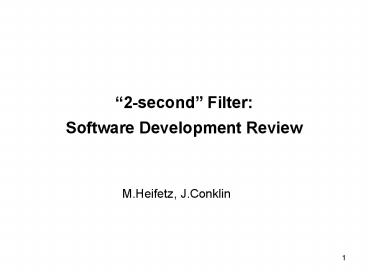2second Filter: Software Development Review - PowerPoint PPT Presentation
Title:
2second Filter: Software Development Review
Description:
Sigma Point Filter (SPF) ... Method: Sigma-point filter. Algorithm: T.Holmes ... Investigate alternative nonlinear estimation techniques: Sigma-point filters ... – PowerPoint PPT presentation
Number of Views:27
Avg rating:3.0/5.0
Title: 2second Filter: Software Development Review
1
2-second Filter Software Development Review
M.Heifetz, J.Conklin
2
Outline
- Fundamentals of 2-sec Filter
- Modular Software Structure
- Schedule of Tests
3
- Four Cornerstones of Filter Development
SQUID Readout Signal Structure Measurement
Model(s)
Gyroscope Motion Torque Model(s)
Estimation Algorithms Numerical Techniques
Algebraic Method Machinery Development and
Experience
4
SQUID Readout Signal Model
- Estimation performed for the data collected
during Guide - Star Valid (GSV) mode
- Pointing
Estimated (?) Torb 24.648770 days
known
5
Scale Factor (Cg) 4 Approaches
- Use TFM scale factor variations as is
(simplest) - Algebraic filter will estimate constant CgLM
only - Use ?Cg model without TFM prior information
(symmetric phase) - Algebraic filter estimates full set of ?Cg
coefficients ank, bnk and CgLM - Use TFM scale factor and estimate correction via
?Cg - Algebraic filter estimates subset of ?Cg
coefficients amn, bmn, and CgLM
6
4. Ideal Approach Exact Polhode Phase
- ?Cg Model using exact polhode phase ?p
- Algebraic filter will estimate CgLM, update TFM
estimates of amn, bmn
7
Gyroscope Motion Torque Model
Misalignment Torque
Roll-resonance Torque
Relativity
TFM
8
- Explicit solution for orientation (Alex S.)
9
Pointing Error Compensation (matching)
- - part of state
vector - (per gyro, per telescope side)
10
GP-B Data Analysis Nonlinear Filtering Problem
Two main approaches
- Iterative Extended Kalman Filter (IEKF)
- widely used in post-flight data analysis
- drawbacks linearization and potentially biased
state-vector estimate
- Sigma Point Filter (SPF)
- recently developed by the aero-astro community
for spacecraft attitude estimation, nonlinear
aerodynamic parameter estimation, and tracking
applications - claims that performance is better than EKF/IEKF
- drawbacks more computationally intensive than
EKF
11
Iterative Extended Kalman Filter (IEKF)
- Iterative linearization process
(1)
(2)
(3)
(4)
12
- Apply linear least-squares estimator (e.g.
square-root information filter)
Output and
- Difficulty Jacobian computation
- analytic
- numerical
13
(No Transcript)
14
List of Modules
15
List of Modules cont.
- Code for all methods exist and have been vetted
- Must be packaged into a single function with
option to select method - For Cg with exact polhode phase (method 4), ?p,
?p should be written to L3 (and L3 speedread) to
drastically reduce execution time
16
List of Modules cont.
17
List of Modules cont.
18
List of Modules cont.
19
List of Modules cont.
- Module IEKF (Primary method)
- Input Z(t), ,
- Output State vector estimate, covariance
matrix, P - Method IEKF (uses Bierman library)
- Algorithm T.Holmes (20), V.Solomonik,
M.Heifetz, J. Conklin - Code V.Solomonik
- Readiness 0 (1 month)
20
List of Modules cont.
21
Two interwoven loops
- Guide Star Valid Data Loop (full mission)
- State vector parameters estimation
- Relativity (rNS, rEW)
- Gyro scale factor coefficients (CgLM, ank , bnk)
- Roll phase offset (d?)
- Telescope scale factor coeffs. (Gyro/Telescope
Matching) (cTi) - Roll-resonance torque parameters (c1mn, c2mn)
- Misalignment torque parameters (k1mn, k2mn)
- Initial orientation (sNS0, sWE0)
22
List of Modules cont.
- Module Truth Model
- Algorithm M.Heifetz, KACST
- Code KACST
- Readiness 0
23
List of Modules cont.
- Module Residuals Analysis
- Goodness-of-fit tests, Residual structure
identification - Algorithms T.Holmes, M.Heifetz, KACST
- Code KACST
- Readiness 0
- Module Geometric Method Integration
- Purpose Apply Geometric Method to s(t) with
Roll-Resonance torque removed - Algorithm M.Keiser, J.Conklin, K. Stahl
- Code K. Stahl
- Readiness 0
24
Data Segmentation
- 10 Data Segments interrupted by anomalous events
- 1) September 13, 2004 September 23 (11 days)
- 2) September 25 November 10 (47 days)
- 3) November 12 December 04 (23 days)
- 4) December 05 December 09 (5 days)
- 5) December 10 January 20, 2005 (42 days)
- 6) January 21 March 04 (43 days)
- 7) March 07 March 15 (9 days)
- 8) March 16 March 18 (3 days)
- 9) March 19 May 27 (70 days)
- 10) May 31 July 23 (54days)
307 days of science data available
25
Schedule of Tests
- Phase 1 Test of baseline configuration
March - April - - Data Segment 5 (or 6)
- - Module Mode 1 ( from TFM)
- - Module Initial profile, no
iterative update - - Matching based on known telescope scale
factors (no update)
- Phase 2 Test of extended baseline configuration
April-June - - Data Segment 5 6
- - Module Mode 2 (Estimated
parameters) - - Module Initial profile, no
iterative update - - Matching estimation of telescope scale
factors
- Phase 3 Full Mission Analysis Test July -
August
26
Modules where KACST can contribute
- Module Residuals Analysis
- Goodness-of-fit tests, Residual model
identification - Algorithms T.Holmes, M.Heifetz, KACST
- Code KACST
27
- Module Truth Model
- Simulate SQUID data and test Estimation Methods
- Algorithms M.Heifetz, KACST
- Code KACST
- Module Optimization
- Interface between optimization package and GP-B
data analysis software - Study optimization package that will be used as a
part of estimation process - This package exploits subroutines written in C
and/or Fortran, and GP-B analysis software is
written in Matlab therefore some interface is
needed for communication between various modules - Algorithm A. Bradley (Stanford Optimization
Lab), J.Conklin - Code K. Stahl, KACST
28
- Module SPF (for Phase 3)
- Investigate alternative nonlinear estimation
techniques Sigma-point filters - Algorithms T.Holmes, M.Heifetz, J. Conklin,
KACST - Code KACST































